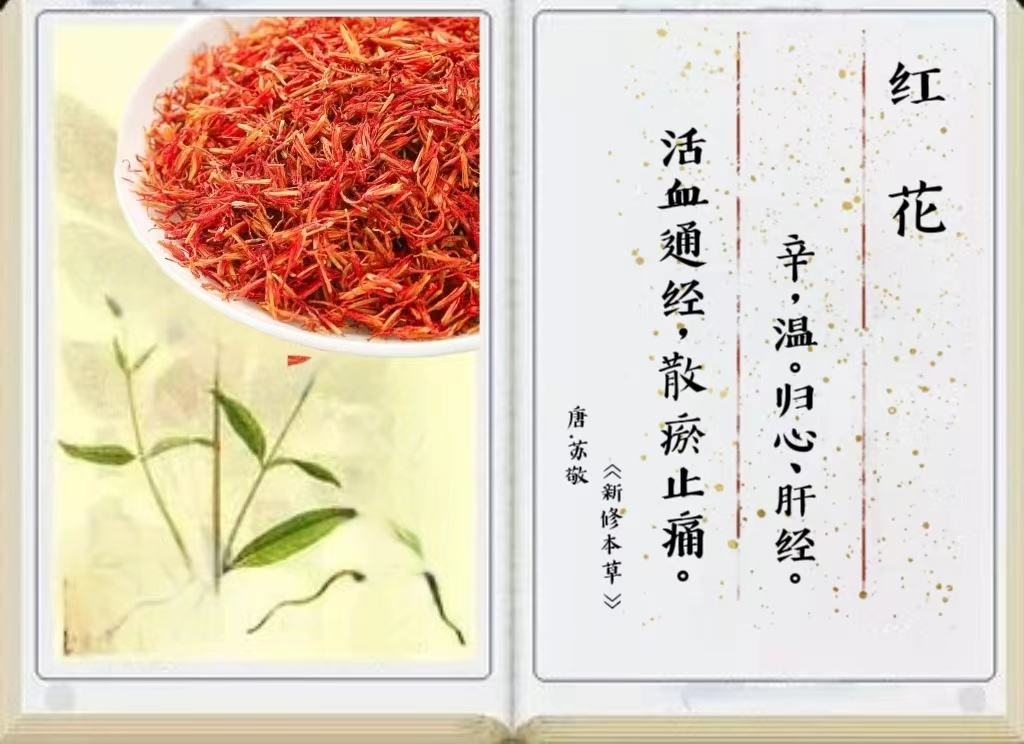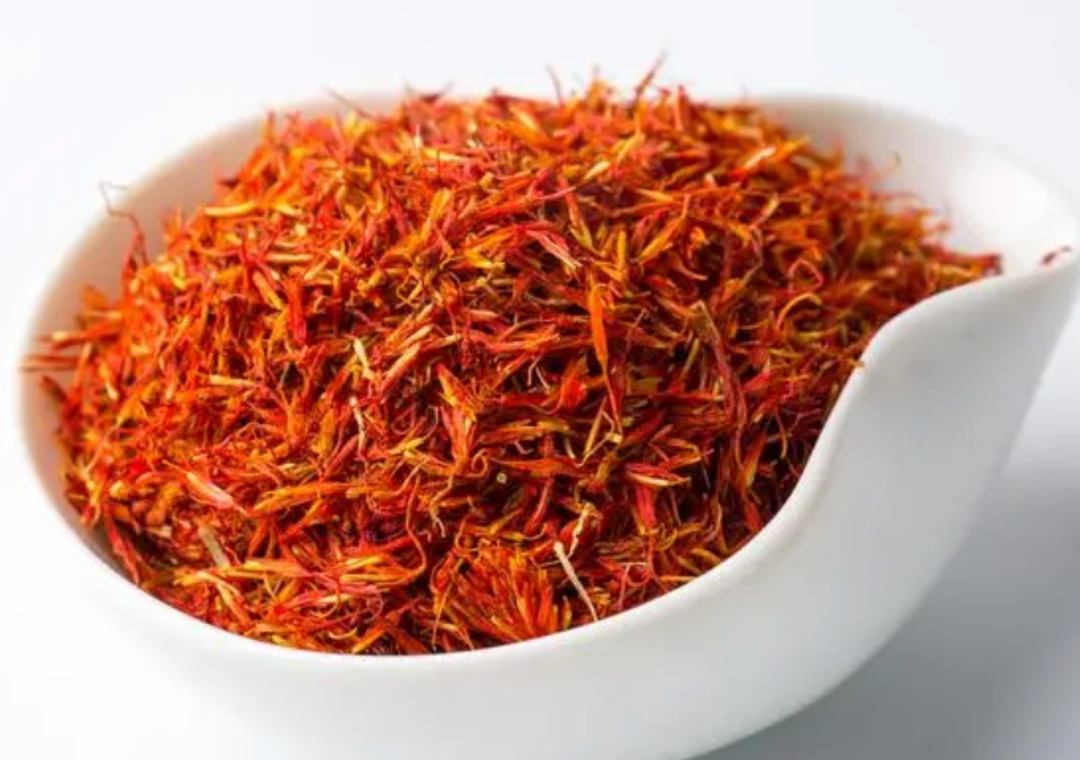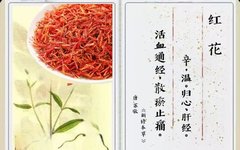Author: Ren Guiling, Ordos Central Hospital
In the drama “Empresses in the Palace,” the usually domineering Hua Fei has her own troubles, asking, “Everyone can give birth, why can’t I?” After drinking the “miscarriage medicine” given by Duan Fei, Hua Fei suffers a miscarriage. In retaliation, Hua Fei forces Duan Fei to drink a pot of safflower, leading to Duan Fei’s inability to conceive again.

Can Safflower Really Cause Infertility?

Safflower, known as Hong Hua (Carthamus tinctorius), is the dried flower of the Asteraceae family. It has a pungent and warm nature, entering the Heart and Liver meridians. It is known for its ability to invigorate blood circulation, alleviate pain, and dispel blood stasis. It is a key herb for treating various blood stasis-related conditions, particularly in gynecology for menstrual pain, postpartum pain, and traumatic injuries.
In cardiovascular clinical practice, it is commonly used to treat coronary heart disease, angina pectoris, stroke, falls, and menstrual irregularities.
Effects on Male and Female Fertility
Impact on Male Reproductive System
Safflower can have adverse effects on male fertility. Multiple animal studies have confirmed that safflower extract has toxic effects on testicular tissue, leading to a reduction in the diameter of seminiferous tubules and a decrease in epithelial height. Safflower also affects sperm formation, thereby impacting sperm quality. It can influence testosterone and sperm production, so it is recommended to avoid safflower when facing reproductive issues or during the preconception period.
Impact on Female Reproductive System
Safflower can negatively affect female fertility as well. Animal studies have shown that safflower extract adversely affects ovarian morphology and female reproductive hormones, leading to a decrease in the number of ovarian follicles, a reduction in both relative and absolute ovarian weight, and lower levels of follicle-stimulating hormone and estrogen in the blood. It is advised to avoid safflower during the preconception period.
Usage Precautions
The typical dosage of safflower is 3-10g for decoction. Safflower has significant embryotoxicity, which can increase the rate of embryonic death and the incidence of intrauterine growth retardation, potentially leading to miscarriage, and it has notable mutagenic effects, so pregnant women should use it cautiously. Safflower can adversely affect the fertility of both men and women, and it is best to avoid its use during reproductive issues and the preconception period.

In Conclusion
Safflower is widely used in clinical practice for various gynecological diseases, such as primary dysmenorrhea, menstrual irregularities, abdominal masses, pelvic blood stasis, postpartum abdominal pain, and incomplete miscarriage endometritis.

However, caution is needed when using safflower; pregnant women should use it cautiously, and it is not recommended during the preconception period.
Safflower can prevent early pregnancy but does not affect subsequent pregnancies.
Although safflower can negatively impact male and female fertility, there is no need to panic. When used under the guidance of a physician or pharmacist and within the recommended dosage and duration, it will not lead to infertility.
Safflower is not only medicinal but also used in cuisine; it is utilized as a seasoning and coloring agent in foods in Italy, France, and the UK, indicating that consuming a small amount of safflower will not cause infertility.
-END-
Images in this article are sourced from the internet for public welfare dissemination. We thank the authors of the images; if there is any infringement, please contact us for removal.

This article is an original work by “PSM Yao Dun Public Welfare”. For reprints, please leave a message.
Reviewed by: Wang Xing, Ordos Central Hospital

References
[1] National Pharmacopoeia Commission. Pharmacopoeia of the People’s Republic of China [M]. Beijing: China Medical Science Press, 2020:157.
[2] Zhou Zhenxiang, Tang Decai, et al. Clinical Chinese Medicine [M]. Beijing: China Traditional Chinese Medicine Press, 2019:182-183.
[3] Bahmanpour S, Vojdani Z, Panjehshahin MR, Hoballah H, Kassas H. Effects of Carthamus tinctorius on Semen Quality and Gonadal Hormone Levels in Partially Sterile Male Rats [J]. Korean J Urol. 2012 Oct;53(10):705-10.
[4] Nasiri K, Akbari A, Nimrouzi M, Ruyvaran M, Mohamadian A. Safflower seed oil improves steroidogenesis and spermatogenesis in rats with type II diabetes mellitus by modulating the genes expression involved in steroidogenesis, inflammation and oxidative stress [J]. J Ethnopharmacol. 2021 Jul 15;275:114139.
[5] Chen Y, Xiang Q, Peng F, Gao S, Yu L, Tang Y, Yang Z, Pu W, Xie X, Peng C. The mechanism of action of safflower total flavonoids in the treatment of endometritis caused by incomplete abortion based on network pharmacology and 16S rDNA sequencing [J]. J Ethnopharmacol. 2023 Oct 28;315:116639.
[6] Delshad E, Yousefi M, Sasannezhad P, Rakhshandeh H, Ayati Z. Medical uses of Carthamus tinctorius L. (Safflower): a comprehensive review from Traditional Medicine to Modern Medicine [J]. Electron Physician. 2018 Apr 25;10(4):6672-6681.
[7] Louei Monfared A, Salati AP. Effects of Carthamus tinctorius L. on the ovarian histomorphology and the female reproductive hormones in mice [J]. Avicenna J Phytomed. 2013;3(2):171–7.


SearchSafflowerRelated Articles

